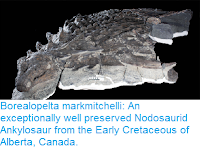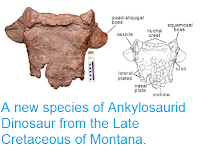Ankylosaurus magniventris was the first Ankylosaurid Dinosaur discovered, and consequently the species that gave the group its name. It is also the largest known species in the group, and, having lived at the very end of the Cretaceous, the last. Despite this the species is much less well known than many less familiar members of the group, with no complete specimens known, only a small amount of fragmentary material. Due to this lack of complete specimens our view of this Dinosaur has changed significantly in the hundred and ten years since it was first described, as new specimens have revealed more about its anatomy.
In a paper published in the journal Facets on 12 October 2017, Victoria Arbour of the Department of Palaeobiology at the Royal Ontario Museum, and the Department of Ecology and Evolutionary Biology at the University of Toronto, and Jordan Mallon of Palaeobiology at the Canadian Museum of Nature, present a new review of Ankylosaurus magniventris, based upon new material that has become available since the last such review in 2014.
Skull of CMN 8880, an Ankylosaurus magniventris specimen described in 2004, in (A) dorsal, (B) ventral, (C) left lateral, and (D) right lateral views. The skull is well preserved on the dorsal and left lateral surfaces. The right lateral surface has caved inwards slightly, and the premaxillary beak is missing. Left lower jaw in (E) lateral and (F) medial view. (G) Dentary tooth in labial view. Arbour & Mallon (2017).
The skull of Ankylosaurus magniventris resemblles that of other Late Cretaceous Ankylosaurids such as Anodontosaurus, Euoplocephalus, Scolosaurus, Ziapelta, and Zuul, though it can be distinguished in a number of ways. It has a distinct keel on its anterior and posterior supraorbital caputegulae (skull elements, which is also seen in some other species, but which, uniquely, is continued onto its squamosal horn, 34-36 teeth in its upper jaw, these teeth being proportionately small compared to other Ankylosaur species and rather variable in size within the species.
Skulls of Ankylosaurus, Euoplocephalus, and Nodocephalosaurus, in left anterolateral view. In Euoplocephalus, the supranarial caputegulum is rugose and forms an arch over the anteriorly placed nasal vestibule. In Ankylosaurus, the nasal vestibule and external naris is roofed by the loreal caputegulum, and the supranarial caputegulum is small and flush with the premaxilla. The holotype of Nodocephalosaurus is poorly preserved in the premaxillary region, but the external nares are also posteriorly placed and may be partly roofed by a ridge-like loreal caputegulum; the supranarial caputegulum is also ridged and projects anteriorly. asca, anterior supraorbital caputegulum; frca, frontal caputegulum; laca, lacrimal caputegulum; loca, loreal caputegulum; mnca, median nasal caputegulum; msca, middle supraorbital caputegulum; mx, maxilla; nasca, nasal caputegulum; nar, external naris; nav, nasal vestibule; nuca, nuchal caputegulum; o, orbit; pmx, premaxilla; psca, posterior supraorbital caputegulum; q, quadrate; qjh, quadratojugal horn; snca, supranarial caputegulum; sqh, squamosal horn. Arbour & Mallon (2017).
All Ankylosaurs are known to have long, complex nasal passages, which presumably also implies a highly developed sense of smell. The external nares (nostril openings in the skull) of Ankylosaurus magniventris are larger than those of other Ankylosaur species, and set further back and higher, and further apart on the skull. Nostrils placed higher on the skull of a terrestrial vertebrate are often a sign of a return to an aquatic or semi-aquatic lifestyle, however nothing else about the anatomy of Ankylosaurus magniventris supports this idea. Such nostril placement is also associated with the development of a flexible proboscis in modern animals such as Elephants, Tapirs and Saiga Antelope, however there is no evidence for any such structure in Ankylosaurus magniventris, and it would seem rather at odds with the beak of the animal, which appears to be its primary food-processing structure, and the use of which would presumably be hampered by the presence of a fleshy proboscis. It has also been suggested that the widely spaced nostrils of the living Moose could provide that animal with a stereolfactory capability, though it has never been shown that Moose have such a sense, or what they do with it if they have it. Ankylosaurus magniventris could presumably also have had stereolfaction, though it is even harder to assess what the advantage of this might have been to a poorly understood Cretaceous Dinosaur than it is to a living Deer.
An alternative explanation for the presence of high-set nostrils is a lifestyle that involves frequent digging. In modern Mammal species such as Pigs, Aardvarks, and Armadillos this is associated with the development of a flesh snout with nostrils mounted on a terminal disk, which again is unlikely in Ankylosaurus magniventris. However this trait is also seen in burrowing animals such as Blind Snakes and Amphisbaenians, which have shovel-like snouts. It is not proposed that Ankylosaurus magniventris is likely to have been a burrowing animal, but it is possible that it used its beak for some digging activity, possibly to search for buried food such as roots or tubers.
All Ankylosaurs posses structures called cervical half rings, armoured structures composed of composed of an underlying band of non-osteodermal bone and an overlying set of six large osteoderms, which provided protection for the neck and shoulders. However the cervical half rings of Ankylosaurus magniventris have been interpreted as having been split into two portions, effectively forming 'quater-rings'. However re-examination of this material by Arbour and Mollon suggests that these structures in fact had an underlying bony band which has not peen preserves and would have held them together as a single structure.
The tail club of Ankylosaurus magniventris is known only from smaller specimens, and is compatible in size to those of other similarly sized Ankylosaur species. However if this is scaled up proportionally to the largest members of the species it would imply a tail club with a width of 120 cm, far in excess of anything seen in any other Ankylosaur. Arbour and Mallon suggest that this is unlikely, as such a structure would place unreasonable stress upon the bones of the tail, and that the club is likely to have been proportionately smaller in the biggest animals.
Partial tail clubs of (A) Anodontosaurus (AMNH 5245) and (B) Ankylosaurus (AMNH 5214) in dorsal view. maj, major knob osteoderm; min, minor knob osteoderm; ns, neural spine; prz, prezygapophysis. Arbour & Mallon (2017).
Reconstructions of Ankylosaurus magniventris have changed considerably since the species was first described, when the tail club was unknown, and the cervical half rings were thought to be associated with the pelvis. While the overall shape of the species is now generally accepted, but reconstructions of the size and mass of the largest specimens still vary considerably. Arbour and Mallon estimate that the largest members of the species may have reached eight meters in length and seven and a half tonnes in mass, comparable to a large male African Elephant. They note that this is toward the upper end of size estimations for the species (something Dinosaur palaeontologists need to be wary of, as there is always a temptation to be the discoverer of the biggest member of any group), however they feel that some smaller interpretations (the smallest estimate gives a mass of only 1.7 tonnes) are considerably less plausible for an animal of elephantine proportions.
Ankylosaurus magniventris as reconstructed by Brown & Kaisen (1908) (far left), Ford (2003) (centre left), Carpenter (2004) (centre right), and Arbour & Mallon (2017) (far right). Brown & Kaisen proposed an arrangement in which the osteoderms are closely spaced and relatively uniform, with pelvic osteoderms united in coossified bands. Ford (2003) provided more space between the osteoderms overall, included a tail club knob, and hypothesised that a pelvic shield was present. Carpenter (2004) suggested that the cervical armour was arranged in quarter rings. Arbour & Mallon suggest that the cervical armour was united into more typical half rings, and provide an updated osteoderm arrangement based on preserved osteoderms in AMNH 5214, AMNH 5895, and AMNH 5866, and comparisons with related species. Arbour & Mallon (2017).
An animal the size of Ankylosaurus magniventris is likely to have been capable of consuming impressive amounts of vegetation. However an estimate of the energy requirements of an ectothermic animal ('cold blooded animal dependent on external sources for body heat) this size suggests that it would have required only 6 kg per day of course Fern material, which seems remarkably low. Alternatively an endothermic animal ('warm blooded' animal capable of generating its own body heat) of the same size would have required about 60 kg per day of similar material. The most common interpretation of Dinosaur physiology today is that they had energy requirements somewhere in between those of modern ectotherms and endotherms, giving Ankylosaurus magniventris a requirement of between 6 and 60 kg of course fern material. However, while the species had a long digestive tract, clearly capable of dealing with low quality plant-matter such as Ferns, its specialist mouth parts, with numerous small teeth packed into a strong beak, suggests that it may have had a more specialized diet, possibly including higher energy foods such as fruits, which would have lowered its overall consumption, though it would increased its foraging time.
Modern Elephants play a significant role in habitat shaping, congregating in large groups which strip bark from trees and often push them over, serving to maintain an open habitat. Ankylosaurs were similar in size to Elephants, and might be expected to have played a similar role in their ecosystems. However there is no evidence that adult Ankylosaurs congregated in groups, as all fossil specimens of these animals found have been solitary. Nor do they appear to have been capable of significantly damaging trees, as their mouthparts seem poorly adapted to stripping bark, and their centre of gravity would have been to low to easily knock trees over. This suggests that Ankylosaurs were not a major influence on the landscape in which they lived, a role that was probably played by the smaller (though still large) and more numerous, herd-forming Hadrosaurs.
See also...










